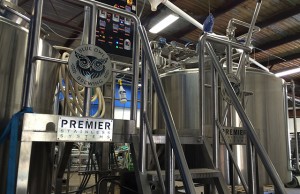
It all started with an idea for a Berliner Weisse with peaches.
Now, Blue Owl Brewing in Austin, Texas is the first production brewery to deal in only sour-mashed beers.
“We are making things that people don’t expect to be a thing,” said Brewmaster Jeff Young. “A Sour Cherry Stout in a can and a Double IPA sour mashed. Not only are we sliding in there to hit the standards but now we have opened all these other doors and people are sharing the excitement with us.”
Opened in late 2015, Young has taken years to perfect a sour-mashing technique that he hopes can shake the stereotype of sour beers as inconsistent. “It was sort of an Epiphany,” he said. “I mean if you can do it for one beer style, why couldn’t you do it for a raspberry porter?”
Using his newly created “Souring Units” (SUs) Young hopes to show patrons and other breweries that sour mashing isn’t a dirty word.
“Sour mashing sort of has a bad rap because people have been doing it wrong for so long,” he explained. “They have been sour mashing in the mash tun and that’s one of the worst places to do your sour mash. You have all this grain matter and husks in there that are basically worthless once you are done mashing.”
If a brewery is trying to sour constantly and still make affordable beer, it has to have a cheap way to inoculate wort. Pure culture of bacteria can be bought, but it’s more expensive that way explained Young.
“You could buy some and form your own culture and just keep propping it up,” he said. “I found that would not allow us to have the differentiate in beer styles because you are taking a large part of your sour wort and adding it to your next wort that you are going to sour and it has a huge impact on what your next beer is going to be.”
Instead, Young created the Modular Inoculation Unit (MIU, pronounced “mew”), basically a “sour tun” in which he runs from his kettle to reinoculate his 30-barrel system’s wort with a smaller, more controlled mash of about $35 of grain. That wort runs through and grabs all the naturally occurring bacteria and wild yeast from the grain.
“It allows me to have a lot of control and repeatability,” Young said. “That is something that sour mash usually suffers from historically is the inconsistencies of it. We can do it pretty much the same every time.”
 Finding out which yeasts and hops work through souring has been a process as well. “We had to figure out the logistics of only brewing sour mash beer along with the fermentation side of things and this whole spectrum of beers in a professional brewery,” Young explained. “We aren’t just using one house yeast, we want a broad spectrum of style of beer. Belgian to Pale Ale to Double IPA we need the cellar principals to accommodate that.”
Finding out which yeasts and hops work through souring has been a process as well. “We had to figure out the logistics of only brewing sour mash beer along with the fermentation side of things and this whole spectrum of beers in a professional brewery,” Young explained. “We aren’t just using one house yeast, we want a broad spectrum of style of beer. Belgian to Pale Ale to Double IPA we need the cellar principals to accommodate that.”
Young said that they expect to make 2,250 bbls off the bat, but may expand up to 8-9,000 bbls with the room they have in the brewhouse.
Much like an IBU scale, Young’s SUs rate the amount of lactic acid in each style of beer they create.
It’s all about titratable acidity.
“When you are sour mashing a beer you are creating mostly lactic acid and a handful of other organic acids but you can treat it all as lactic acid,” Young said. “You can titrate whatever you are souring to find out the titratable acidity. That gives you a measurable amount of lactic acid in a solution. So if you find a half percent in the solution, it’s about a medium-low amount so we take that range and factor it by 100 and call its sourness units level of 50.
“You can start to notice sourness in the 20-30 range but once you get up to 50 you get it to be noticeable but its lower and then that goes up to about 85 or 90 — or .85 or .9 percent of lactic acid.”
Those numbers help keep Blue Owl consistent and it allows it to change sourness from style to style.
“Some beers are better at lower levels,” Young said. “A Berliner Weisse is on the low end because otherwise that sourness would tend to become single note and lemony or citrusy.
When its lower, near 50, it opens up more and you get more complexity from the subtle organic acids and the wheat.”
Currently, they offer four core brands, in order by SUs: a Sour Session Wheat Ale (“Little Boss”), a Sour Pale Ale (“Spirit Animal”), a Sour Red Ale (“Van Dayum“), and a Sour Cherry Stout (“Professor Black”). Little Boss and Spirit Animal are now available and Professor Black is soon to hit shelves in Austin.
“We keep hearing from strangers how they picked one of our beers up once and now it’s their go-to beer,” said General Manager Suzy Shaffer. “It’s a strange, additive thing.”







Be the first to comment